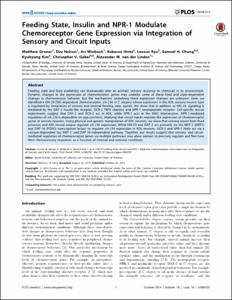Department of Brain Sciences
The K. Kim Lab of Neurobehavior and Neural Circuits
1. Journal Articles
Feeding State, Insulin and NPR-1 Modulate Chemoreceptor Gene Expression via Integration of Sensory and Circuit Inputs
- Title
- Feeding State, Insulin and NPR-1 Modulate Chemoreceptor Gene Expression via Integration of Sensory and Circuit Inputs
- Author(s)
- Gruner, Matthew ; Nelson, Dru ; Winbush, Ari ; Hintz, Rebecca ; Ryu, Lee sun ; Chung, Samuel H. ; Kim, Kyu Hyung ; Gabel, Chrisopher V. ; van der Linden, Alexander M.
- Issued Date
- 2014-10
- Citation
- PLoS Genetics, v.10, no.10
- Type
- Article
- Keywords
- TRANSCRIPTION FACTOR ; RECEPTOR EXPRESSION ; SOCIAL-BEHAVIOR ; FOOD RESPONSE ; NEURONS ; DAF-16 ; LONGEVITY ; MOSQUITO ; PATHWAYS ; MEF2
- ISSN
- 1553-7390
- Abstract
- Feeding state and food availability can dramatically alter an animals' sensory response to chemicals in its environment. Dynamic changes in the expression of chemoreceptor genes may underlie some of these food and state-dependent changes in chemosensory behavior, but the mechanisms underlying these expression changes are unknown. Here, we identified a KIN-29 (SIK)-dependent chemoreceptor, srh-234, in C. elegans whose expression in the ADL sensory neuron type is regulated by integration of sensory and internal feeding state signals. We show that in addition to KIN-29, signaling is mediated by the DAF-2 insulin-like receptor, OCR-2 TRPV channel, and NPR-1 neuropeptide receptor. Cell-specific rescue experiments suggest that DAF-2 and OCR-2 act in ADL, while NPR-1 acts in the RMG interneurons. NPR-1-mediated regulation of srh-234 is dependent on gap-junctions, implying that circuit inputs regulate the expression of chemoreceptor genes in sensory neurons. Using physical and genetic manipulation of ADL neurons, we show that sensory inputs from food presence and ADL neural output regulate srh-234 expression. While KIN-29 and DAF-2 act primarily via the MEF-2 (MEF2) and DAF-16 (FOXO) transcription factors to regulate srh-234 expression in ADL neurons, OCR-2 and NPR-1 likely act via a calcium-dependent but MEF-2- and DAF-16-independent pathway. Together, our results suggest that sensory- and circuit-mediated regulation of chemoreceptor genes via multiple pathways may allow animals to precisely regulate and fine-tune their chemosensory responses as a function of internal and external conditions. © 2014 Gruner et al.
- Publisher
- Public Library of Science
- Related Researcher
-
-
Kim, Kyuhyung
- Research Interests Neurobehavior; Neural Circuit; Neurodevelopment; 신경회로; 신경행동; 신경발생; 신경유전학
-
- Files in This Item:
-

10.1371_journal.pgen.1004707.pdf
기타 데이터 / 1.43 MB / Adobe PDF download
- Appears in Collections:
- Department of Brain Sciences The K. Kim Lab of Neurobehavior and Neural Circuits 1. Journal Articles



